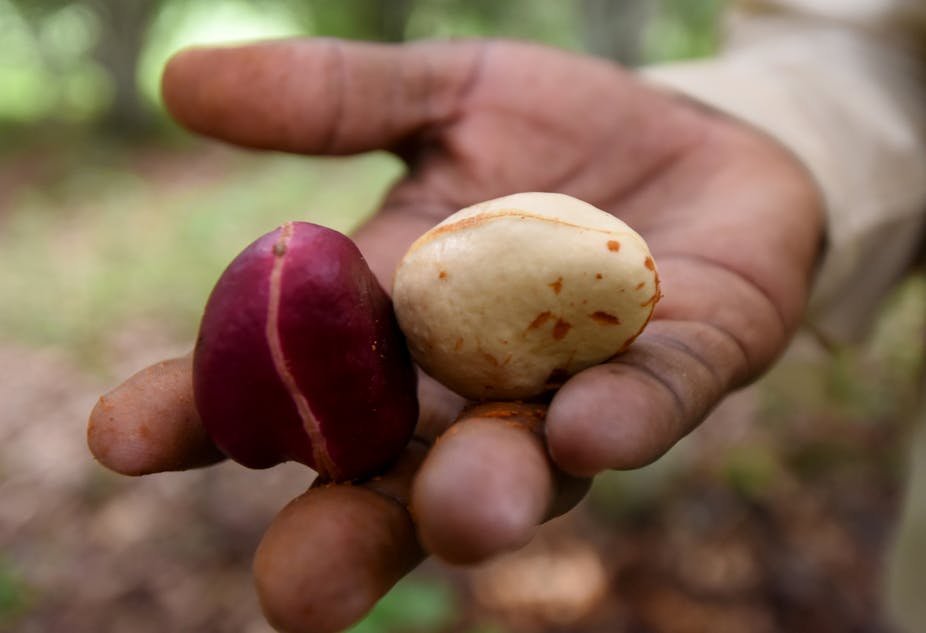The kola nut tree is grown for its seed. The tree is indigenous to west Africa, where it is widely cultivated. It’s now also found in Asia, South America and the Caribbean.
World production of kola nut was about 311,331 tonnes in 2021. Over 90% of the world’s kola nut is produced in west Africa, where Nigeria contributes 50%, Cameroon 27%, Côte d'Ivoire 16% and Ghana 8%.
The most popular species are Cola nitida (known in west Africa as gbànja in the Yòrùbá language; oji in Igbo; gworo in Hausa) and Cola acuminata (àbàtà, Yòrùbá).
Kola nut contains natural chemicals that act as a stimulant when eaten. It is part of the culture and tradition of some Nigerians. For example, it is offered as a gesture of hospitality among the Igbo. It is used for divination and in ceremonies by the Yòrùbá. Hausa people chew it to reduce hunger.
Parts of the plant are widely used in folk medicine, to treat overweight, pains, cough, malaria, infertility, dysentery, typhoid fever, herpes, rheumatism, arthritis and various infections. It is rich in phytochemicals – compounds produced by plants.
The nuts are also used as flavouring agents and incorporated into energy drinks and pharmaceuticals.
Our research over the past 10 years has focused on other potential uses of kola. We have tested different parts of the tree – its seed, seed shell, pod and leaf – in our laboratory in Ogbomoso, western Nigeria.
Our experiments showed that, through biotechnology and nanotechnology, there are potential new uses in areas like agriculture and health.
Biotechnology and nanotechnology
Biotechnology uses living organisms to make different products. For instance, yeast is a living organism which is used to produce bread.
Nanotechnology makes and uses structures, devices and systems by controlling shape and size at the nanoscale. One nanometre is a billionth of a metre. It has applications in agriculture, industry, medicine, the environment and consumer products.
Our laboratory uses both technologies.
For example, we have used nanoparticles to improve the yield of citric acid by black mold in cashew apple juice medium. Our nanotechnology research group also made the first attempt to produce nanotextiles using cotton and silk in Nigeria. We used silver and silver-titanium oxide nanoparticles produced by locust beans’ wastewater to modify the fabric. Locust bean is a multipurpose tree legume found in Nigeria and some other parts of Africa.
Our experiments have shown, too, that nanoparticles produced using kola nut can be applied in agriculture, the environment and healthcare.
Applying technologies to kola nut
Since 2015, we have used the kola plant to produce different types of nanoparticles. These include silver nanoparticles synthesised by the pod, seed and seed shell, and alloy nanoparticles.
Other synthesised nanoparticles are titanium dioxide, titanium-silver alloy, calcium, and magnesium oxide.
Read more: How nanotechnology can revive Nigeria's textile industry
We found that the kola nut provided chemicals that catalysed the formation of nanoparticles. The nanoparticles were active against disease-causing bacteria and fungi, prevented coagulation of blood and degraded some dyes. Some of them also promoted growth of vegetables and Moringa.
In a recent publication, we reviewed the ways that kola nut can be used to produce biofuel, dyes and animal feeds. Other uses are production of nanomaterials, enzymes, biofertilizer, activated carbon and pesticides. Their extracts also offer protection against corrosion of metals.
Kola nut for sustainable development
We have detailed the importance of kola nut in catalysis, renewable energy, adsorption technology, corrosion inhibition, feed technology, and nanobiotechnology. These products can be applied to achieve sustainable development goals – zero hunger, affordable and clean energy, clean water and sanitation, good health and wellbeing, and industry, innovation and infrastructure.
We argue in our latest paper that it’s possible to turn unused and waste materials from kola nut processing into new products using eco-friendly processes.
Nigeria generates an estimated 90,000 tonnes of waste pod and shell from kola nut processing annually. Our research shows that these wastes can be used to produce important products.
Read more: How Nigeria can turn its huge cashew waste into valuable citric acid
Our investigations have shown that kola nut holds a lot of potential. The waste from its processing is a “gold mine” that could be used to create wealth by producing valuable products. Nigeria’s cultivation of kola nut should be expanded for this purpose. New high yielding varieties are needed to increase productivity. This will create material resources that can be deployed in biotechnology, catalysis and nanotechnology to contribute to the nation’s economy.


